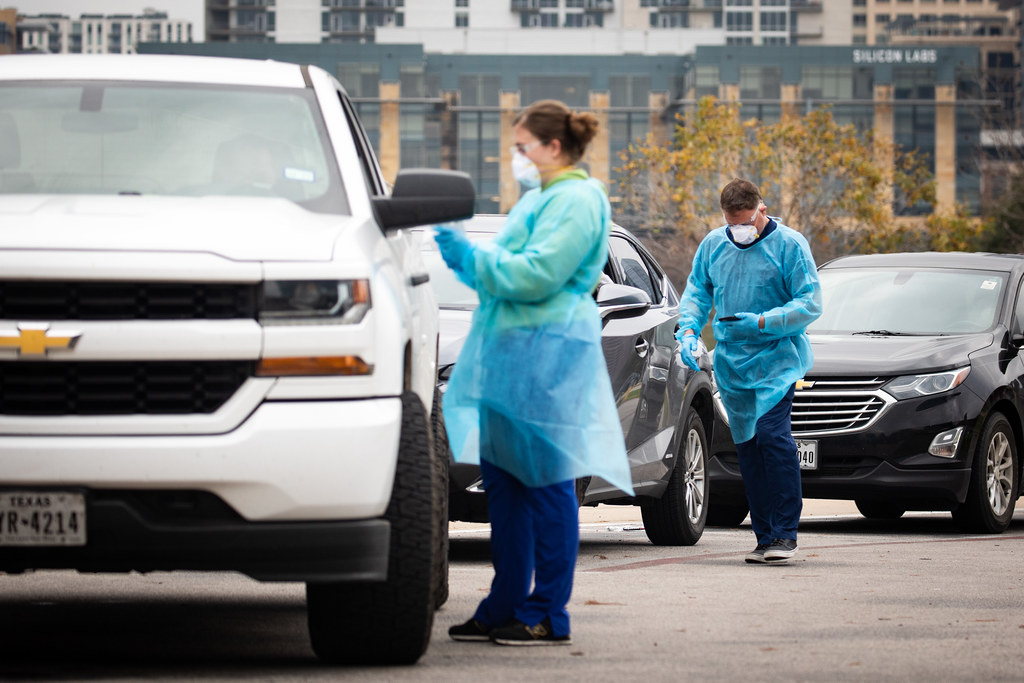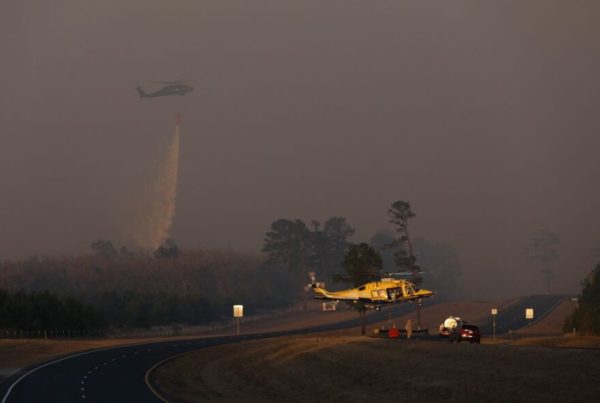Is Texas nearing the peak of this latest surge of COVID-19? The omicron variant of the coronavirus has spread widely throughout the state, like elsewhere in the country, and the overall growth of cases and hospitalizations could be a sign that we’re nearing the peak soon.
Anass Bouchnita with the University of Texas at Austin’s COVID-19 Modeling Consortium develops simulations to try to determine what, exactly, the peak might look like. He tells Texas Standard that the simulations take into account things like “immunity in the population; vaccination coverage; behavior of the people, like contact rates, and so on,” to gauge what the virus might do next. Listen to the interview with Bouchnita in the audio player above or read the transcript below to learn more.
This interview has been lightly edited for clarity.
Texas Standard: Some reporting suggests that some states, especially in the Northeast, may be approaching a peak with the omicron variant. What are you hearing, and what can you tell about Texas?
Anass Bouchnita: I think at this point it’s too early to say whether we have reached a peak or no. We know that the peak is reached when there are sufficient levels of immunity in the population and the virus has some sort of difficulty in infecting as many people as it has infected before. And in Texas, I think it’s too early to say if we have reached the peak or not yet, because during the last three days, we know that there was some sort of underreporting that was mainly due to the weekend and the Martin Luther King Jr. holiday. However, when we look at the doubling rates of cases and the overall growth of cases and hospitalizations, then this suggests that we are getting there very soon.
How do you know that you’ve approached a peak? Are you looking for some sort of specific number of cases and hospitalizations, or what exactly?
We make projections and these projections takes into consideration all the information that we have in terms of immunity in the population, vaccination coverage, behavior of the people like contact rates and so on. And we try to integrate this with the knowledge that we have on omicron and on COVID-19 transmission. This allows us to make some mathematical computation to make what we call “numerical simulations,” and try to simulate what will happen in a computer under different assumptions.
Let’s talk about what has been going on: I guess other countries give you the greatest insight, I would presume?
Absolutely. And this is especially true for the situation of omicron because it started in South Africa, and the only data that we had at the beginning of the omicron emergence were coming from South Africa. And we were trying to benefit from this data as much as possible, but we had to keep in mind that the situation in [South] Africa, in terms of community behavior, population, demographics and so on is completely different from the U.S. But you are absolutely right; the data that we are using has partially come in from other countries, and this is especially true regarding omicron severity and growth advantage.
As you look in the aggregate, what can you say about how long it is taking for other countries to emerge from surges of the omicron variant?
I think there are some countries that seem to be already in the peak or have already exceeded the peak, like the United Kingdom and Canada, and maybe also some Scandinavian countries. And of course, we we shouldn’t forget the case of South Africa that seems to have already reached manageable numbers of cases. So I think the U.S. is still a little bit lagging behind the United Kingdom and Canada, but we expect that we will be reaching the peak, maybe this week or the beginning of the next one.
Well, that is encouraging news. But what happens once we start to see declines in hospitalizations and case rates for omicron? Can we expect new variants to emerge?
I think when people hear about stats, that we have “exceeded the peak,” they think that we have reached a situation where, basically, we have exceeded the danger zone. However, in reality, the situation is that even when we exceed the peak, then there are still people getting infected and there are still people getting hospitalized.
And so mathematically, more than half of the people who would be infected would be infected after the peak. And this suggests that we have to keep being vigilant and we have we have to keep being cautious, otherwise we might see a new wave before the numbers of cases and hospitalizations decline by a significant level.
Some people argue that COVID-19 is going to become an endemic disease, rather than a pandemic that we experience in waves. What’s your thinking on that?
I think at this level there is still a lot of uncertainty, and there are different scenarios that could happen. So, all what we were thinking about COVID at the beginning seems to be not very accurate, and now we have new variants that keep emerging. It seems that since immunity wanes, then there will be always some COVID circulating, whether omicron or a new variant. And this means that there is always a potential for new surges if immunity levels go very low and the behavior changes such that there are more contacts and more mixing.
Now the question is, what will these new waves or these new surges look like? Will they be milder or will they be as severe in terms of hospitalizations as the one that we’ve seen so far?
So you’re saying that’s the question: “What do we see in future variants and behaviors?“
Yes, I think so.














